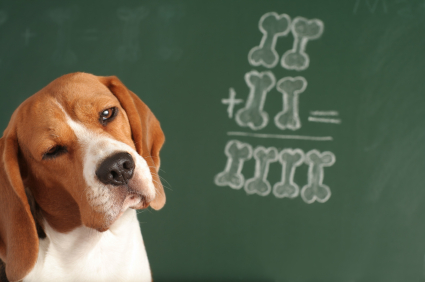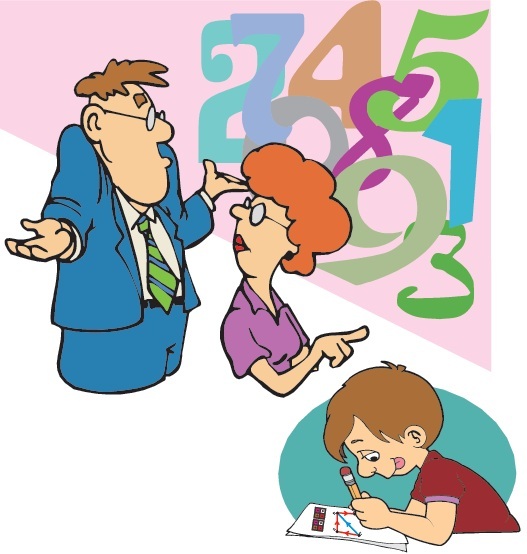
Note: This story is adapted from our IMACS Math Enrichment Program for talented students in grades 1-8. The solution and analytical process are revealed at the end of this post, so don’t scroll down too far if you want to avoid the spoiler!
Max, The Lost Dog
Sofia, a bright IMACS student, has lost her dog, Max. Luckily, Max was wearing a collar when he was found by another IMACS student, Emily, who loves using her logical reasoning skills to solve mysteries. Tucked into the collar was a piece of paper with clues on where to return Max should he become lost. Follow the clues to help Emily find which house is Max’s so that Sofia can be reunited with her dog … and possibly make a new friend in Emily. (Since both girls take online math classes through eIMACS, they had not met each other yet.)
Clue 1: The number of the house where Max lives is the sum of two numbers, each of which is a power of 2 that is greater than 0 and less than 10. These two numbers that add up to equal Max’s house number can be the same, but they don’t have to be.
Clue 2: Max lives in Galois Gardens, a neighborhood represented by the following arrow diagram in which each dot represents a house.
The fork to the left is Leibniz Lane, the fork to the right is Abelian Avenue, and the house at the bottom is on Via Vertex. Here is how you interpret the arrows:
• The house number at the end of a red arrow is equal to the house number at the start of that red arrow plus 3.
• The house number at the end of a blue arrow is equal to the house number at the start of that blue arrow plus 4.
Clue 3: The biggest number for any house in the neighborhood is 15.
Clue 4: The number of the house where Max lives is a multiple of 3.
The Analytical Process of Solving the Mystery
Now that you’ve given yourself a chance to work through the problem, let’s go step by step to understand one way we can think about putting the clues together.
Clue 1: What are the powers of 2 that are greater than 0 and less that 10? They are 1=20, 2=21, 4=22, and 8=23. So we need to take one number from the set {1,2,4,8} and a second number from the same set {1,2,4,8} and add them together to come up with the list of possible house numbers. Remember that both numbers can be the same but do not have to be. We’ll leave the arithmetic to you, but we should all arrive at the following possibilities:
Clue 2: Although we don’t yet know any of the house numbers in the arrow diagram of the neighborhood, what can we figure out from the information given? One thing is the location of the house with the smallest number. It has to be the house at the bottom of the picture because the arrows tell us that every time you go from that house along either of the two roads, you add 3 or 4 each time. So you keep getting bigger and bigger house numbers, and they never fall back below the number you started with at the bottom, whatever that number is.
Likewise, is there anything we can say about the largest house number in the neighborhood? Well, it’s probably at the top of the diagram since the house numbers get bigger as you go up the roads. But is it the house on the top left or the one on the top right? Now we need some variables now to help us keep track of these houses.
Let’s call the house number at the bottom “A,” the one on the top left “B,” and the one on the top right “C.”
We know B is bigger than A, and C is bigger than A. Can we say anything about how much bigger B and C are than A? Well, to get from A to B, we add 3 and 3 and 4. That is, we add 10 = 3 + 3 + 4. So A + 10 = B. To get from A to C, we add 4 and 4 and 3. That is, we add 11 = 4 + 4 + 3. So A + 11 = C. We’re starting with at same number, A, and adding 11 to get to C but only 10 to get to B, so C must be bigger than B. Now we know that the house with the biggest number is on the top right.
Clue 3: This clue, along with what we figured out from Clue 2, tells us that C = 15. In other words, the address of the house at the top right is 15 Abelian Avenue. With a little arithmetic, we can now determine the rest of the addresses in the neighborhood as follows:
Now that we have all the addresses in the neighborhood, we can go back to our original list of possible house numbers from Clue 1 and cross off the ones that do not show up in the neighborhood. Here’s what our list should look like now:
Clue 4: We’re down to only three possible house numbers—4, 8, and 12. Clue 4 tells us that the house number is a multiple of 3. Which of these possibilities is a multiple of 3? Only 12 is a multiple of 3. Hooray! We figured out where Max lives—12 Abelian Avenue! Sofia will be so happy to have Max back at home, and Emily will be quite pleased with herself for having solved the mystery and done a good deed.
Show a child some tricks and he will survive this week’s math lesson. Teach a child to think critically and his mind will thrive for a lifetime.
Math word problems confound many students for a variety of reasons. Too often, well meaning parents and teachers attempt to help students struggling with these kinds of problems by offering them tricks or shortcuts for getting to the solution without necessarily understanding what’s going on. Just do an internet search for something like “how to solve word problems,” and you will get a slew of Web pages with tips, tricks and strategies like the following:
• Search for key words that will tell you which mathematical operation you should use (e.g., “lost” means subtraction).
• Cross out non-essential information so that you are not distracted by it.
• Draw a picture to illustrate each step of a problem.
Let’s consider these three examples for a moment. To suggest that looking for key words within the text of a math problem is somehow a “strategy” to solving it more easily seems a bit absurd. Basic reading comprehension skills are obviously essential to solving any problem, math or otherwise, where the information is communicated via natural language. No key word mapping is going to provide a fool-proof way of understanding what a word problem is asking. If you’re starting with a word problem that is well designed and written with clarity, there simply is no “trick” to understanding the words.
The other two examples sound reasonable on the surface, but a closer examination reveals problems with them too. To determine which pieces of information are relevant to the solution (as in Example #2), you need to be able to evaluate and analyze the given information. To correctly translate the words of a problem into a step-by-step illustration (as in Example #3), you need to be able to understand and prioritize the information. In other words, tricks like these seem to require the very skills needed to solve the problem without the tricks! Furthermore, a “tip” cannot tell you whether you have enough information to solve the problem, or how to find any missing information. Only critical thinking and logical reasoning skills can help you there.
This approach of relying on “clever strategies” to replace critical thinking runs counter to the IMACS philosophy of teaching children the fundamental skills they need to solve problems throughout their lives, whether they be elementary word problems or complex Calculus problems, whether it’s making correct change or correcting the flight path of an exoplanet-bound space craft.
Meaningful Strategies That Matter
While silly tricks may work for some students as a short-term fix to “just get through the problem,” there are practical and helpful techniques that should be part of any meaningful approach to understanding and solving word problems.
Pay attention to units of measurement. Word problems commonly feature units of measurement. When finding a solution, it’s important to pay close attention to how you are adding, subtracting, multiplying, or dividing amounts in the problem so that you don’t end up combining “apples and oranges.” If you carefully track the units of measurement through each step of your computation, you can compare the units of your answer to what it should be based on the question. This is a good technique to check the reasonableness of your answer rather than one that “magically” solves the problem for you. Here’s an example:
No one would think that the following approach is right
because adding children to cookies makes no sense! The answer requires a relationship in the form of “X cookies per child” – or, more algebraically,
With this in mind, what makes sense is the following:
While we’re on the topic of cookies, here’s another example:
Most people know to do something with ( 4,500 / 3 ) and 5, but what? Looking at the question in the problem, we know that our answer should be in the form of “X cookies.”
What if we set up the equation correctly
but then worked out our answer as follows?
Hmm … 300 cookies per minute per minute? The fact that our answer is not measured purely in cookies as expected tells us that we made a mistake in our calculation.
Use reverse word problems to practice abstract thinking. The process of solving word problems often requires us to connect a real-life situation described in language we know with the abstract version written with variables and equations. As with learning to speak a foreign language, thinking abstractly becomes more natural with practice and regular use, and the earlier you start, the easier it is.
When kids are younger, parents can help them to develop an intuition for abstract reasoning by doing “reverse” word problems in the guise of creative play. Start by writing down an equation such as 7 + ___ = 10. Next, ask your child to imagine a story that goes with this equation. He might say something like, “It takes 10 gold stars to get extra recess, and I already have 7. How many more stars do I need?” For 3 + (8 × 2) = 19, she might say, “When I started robotics, I took 3 introductory classes. Then, I took 2 classes per week for 8 weeks. So, I have taken a total of 19 classes.”
Be sure to keep the level of difficulty appropriate for your child’s math ability. Frustrating him with a computationally hard problem will only defeat the purpose of teaching him to think abstractly.
Word problems can be used effectively to teach important mathematical concepts and to help give real-world context and purpose to what may seem like useless hieroglyphics to some people. But without a firm foundation in critical thinking and logical reasoning skills, a student is sure to be at a disadvantage when trying to evaluate, analyze, prioritize, and synthesize the numerous pieces of information embedded in the narrative. Tips, tricks, and strategies may help at the margins, but there is simply no substitute for genuine understanding.













